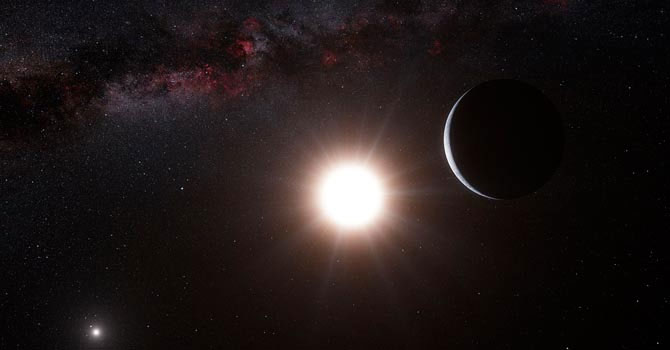Discovering the planet is nearly the same weight as the Earth
Astronomers are looking for a world like Earth that will not need to search further than even our closest star system - Alpha Centauri.
A planet the size of Earth has been discovered circling around a star in the system, just 4.4 light-years away. This discovery was published in Nature today (October 18, 2012).
The planet weighs nearly the weight of the earth, but its orbit does not. It is close to the central star about 25 times more than the distance from the Earth to the sun - the planet appears to be a dry world without the possibility of survival.
However, this discovery burnt the dream of sending a spaceship to Alpha Centauri.

Astronomer Debra Fischer of Yale University said, "A rock planet around Alpha Centauri, our closest neighbor - this is amazing . " "If you're planning to launch a spaceship anywhere or explore anywhere, that's where you should go first. And if you have proof that there are rocky planets there, you have to crazy to ignore this goal '.
This rocky planet circles around Alpha Centauri B, a star that is only smaller and slightly cooler than the sun. However, for a year on this planet only lasts 3,236 days, this planet is not the 'twin brother' of the earth. Being too close to the central star means that the surface temperature of the planet is about 1200 degrees Celsius - astronomer Greg Laughlin of the University of California, Santa Cruz said: 'It is completely uninhabitable, completely burned and not like Earth in every aspect '.
However, a rocky planet too close to Alpha Centauri B suggests that there may be many planets in the same system - maybe a rocky planet is a little further away, at the periphery, where the life can grow.'I think the ability to have an attractive planet, a really interesting planet in this system is very high,' Laughlin said.
Data returned from NASA's Kepler spacecraft - the ship searching for planets among stars about 600 light-years away - shows that multi-planetary systems are very popular, especially When small, planetary planets are found in close orbits.
There's also a good chance that Alpha Centauri A, a larger constellation, also has planets around it. However Alpha Centauri A is bigger, brighter and 'hotter', any small planet orbiting it will be hard to find.
Previous observations showed that no planet larger than Neptune hovered around any of Alpha Centauri's three stars. However, these observations do not exclude smaller planets.
Led by a team at the University of Geneva, astronomers discovered the planet using HARPS high-precision telescopes. They were not surprised to find the aforementioned stone planet.
"We know that these planets are everywhere. The question is, how big are they and how far they are from the star. That's what we are trying to describe ," said the astronomer. Study and research co-author Stephane Udry of the University of Geneva said, "That will help us understand how they form."
HARPS is installed on the 3.6m telescope at the Southern European Observatory in La Silla, Chile, to search for stars that are strongly absorbing the orbits of the planets.
- Discovering the planet is very similar to the earth
- Discovering the planet can survive life
- How many kilograms does the Earth weigh and how to weigh it?
- Discovering strange planets that have 4
- Discovering the twin planet of Jupiter
- Discovering the planet has a year of 18 hours on Earth
- The most Earth-like planet shows up
- Discovering the 'hell version' of the Earth
- Discovering the planet 13,000 light-years away from Earth
- Do you know Earth is less than 50,000 tons per year?
- What happens if everyone on Earth dances for a while?
- Your planet is closest to Earth
 Van Allen's belt and evidence that the Apollo 11 mission to the Moon was myth
Van Allen's belt and evidence that the Apollo 11 mission to the Moon was myth The levels of civilization in the universe (Kardashev scale)
The levels of civilization in the universe (Kardashev scale) Today Mars, the sun and the Earth are aligned
Today Mars, the sun and the Earth are aligned The Amazon owner announced a secret plan to build a space base for thousands of people
The Amazon owner announced a secret plan to build a space base for thousands of people